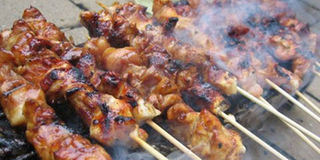Muchomo – meat on the stick

Skewers of meat roasting over a fire. Muchomo has come to be a convenient street food. Photo by Ismail Kezaala.
What you need to know:
What is a celebration without meat in Uganda? None if you ask me, and what better form than muchomo. While this roasted meat or chicken can be enjoyed as a barbecue, the most popular form has become the street food that is popular in most suburbs in town.
Ever had that journey to Masaka and stopped by Lukaya or Namawojjolo as you head to Jinja? Does the name Nakulabye resonate with some nyama choma in your mouth? In Swahili from where the term originated, muchomo refers to an act of celebration that follows a victorious finish.
The triumph in Uganda was always celebrated with roasted meat and thus the name muchomo was coined. Muchomo has come to be known as meat/ chicken roasted over open fire, barbecue is the more formal reference.
Like for many open air roasted foods, it is this scrumptious aroma that keeps many coming back to savour muchomo.
So what makes muchomo tick?
Unknown to many, the mystery of muchomo lies in the roasting and smoking. The roasting process magically draws out the flavours in the meat. The smoke on the other hand chokes you, wets your appetite and evokes the memories that surrounded bull roasting in the past.
According to Yusuf Mugerwa, a vendor in Kireka, on whose skewers lies beef, sausages and chicken, muchomo is intertwined with our past. “From age to age, men have always liked meat, and if it is roasted meat, it tastes very natural.” Mugerwa adds on that, “Unlike meat that is fried and riddled with curry powder, muchomo is simply meat being roasted with no additives.”
Preparing it to fit taste
However, at Mugerwa’s stall just below Gaming International Kireka, onions are smashed and the juice is used to marinate the muchomo. “Apart from onion juice, we sometimes use the liquid from ginger before roasting the meat.”
However, for the chicken, only salt is sprinkled and no other spice is used. “In case one wants the meat to get ready faster, pineapple or lemon juice that is acidic in nature is sprinkled on the meat and this helps the heat to penetrate deeper and faster into the meat,” explains Mugerwa. Most people enjoy their muchomo well done. “But the tastes and preferences differ, some like it medium, while others want it completely dry,” notes Mugerwa. In order to ensure that the meat is ready, some ash is sprinkled on the charcoal such that the heat is slower but its effect is deeper. “Too much heat will quickly bring up a crunchy look on the meat that will mislead one into thinking that the meat is actually ready.”
Hope Mbabazi, who loves the fleshy delicacy says every evening she saves Shs1000 for a stick of beef muchomo from a roadside vendor. “Smoked meat tastes different, the aroma is irresistible and the same holds for the roasted sausages compared to fried ones,” she says.
“From the young to the old, everyone likes muchomo, it knows no class, it knows no tribe,” brags Mugerwa. “Those in cars are usually fans of chicken muchomo but average passersby enjoy the beef muchomo and the roasted sausages.” The chicken muchomo ranges between Shs 3000-Shs 4000. Beef muchomo rances between Shs1000- Shs3000.




